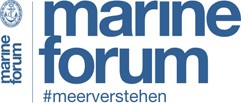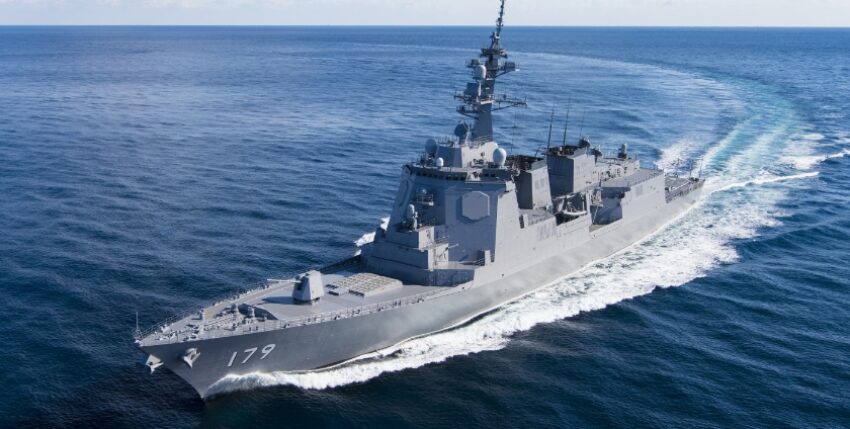With the ASEV, the Japanese navy is their heaviest ever with guided weapons class of warships. The ships are designed for future use of laser and Railgun weapons.
The Japanese Navy (internationally known as the JMSDF or Japanese Maritime Self-Defence Force) currently has eight guided-missile destroyers, including two units of the Maya class launched in 2020. The eight destroyers are multi-purpose combat ships and all have the AEGIS command and control system as well as the AN/SPY-1D fire control radar. Among other things, the ships are armed with SM-3 missiles, which are designed to combat ballistic missiles including medium-range missiles (Anti-Ballistic Missile - ABM). By 2032, the Japanese Navy plans to have two more AEGIS destroyer "of the next technological generation".
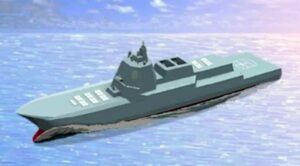
Over the course of the last decade, the guided missile destroyers have been increasingly integrated into ABM operations in order to counter the growing threat from North Korean missiles. This has come at the expense of their ability to carry out their traditional missions - maritime target engagement, submarine hunting and defence against conventional air targets. In view of the growing challenge posed by the Chinese fleet, this commitment is no longer sustainable.
To protect Japan's main islands from North Korean missiles (and to relieve the pressure on its destroyers), Tokyo therefore decided in 2017 to set up two land-based AEGIS Ashore facilities with SM-3 interceptor missiles. However, this project was cancelled in 2020, partly due to concerns that the ejected stages of the interceptor missiles could fall on civilian areas. In place of the AEGIS Ashore facilities, the Ministry of Defence decided to acquire two warships optimised for ABM. These are not destroyers, but a separate category of ship with the provisional designation Aegis System Equipped Vessel (ASEV). In terms of size, the ASEV ships resemble cruisers.
Design, technology, performance
Between June and August 2023, Tokyo published several defence planning documents, including the new budget request for 2024. These documents reveal many details about this ship project.
Original concept designs for ASEV showed a hull based on amphibious warships with an estimated displacement of around 20,000 tonnes. The planned size has since been downgraded. The latest designs show a conventional hull shape based on that of a destroyer or cruiser. The Japanese Ministry of Defence announced on 8 August that the new ships will have a basic displacement of around 12,000 tonnes, around 50 percent more than the Maya class and 30 percent more than US Navy cruisers of the Ticonderoga class. With a hull length of 191 metres and a beam of 25 metres, ASEV will be 20 metres longer and almost three metres wider than the Maya class, and also 16 metres longer than the Ticonderoga class. In the new configuration, the ships are expected to reach a speed of 30 knots, compared to an estimated speed of only 18 knots for the original 20,000 tonne design. The crew is expected to consist of around 240 people (Maya class: 300). This suggests that ASEV vessels will be equipped with a high degree of automation to reduce the crew's workload.
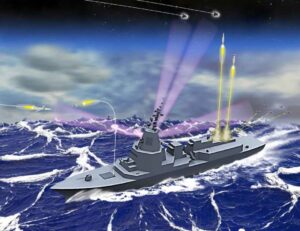
Details of the propulsion system and power generation equipment have not yet been announced. What is certain, however, is that the on-board power requirements will be significantly higher than on the destroyers in order to supply new, more powerful sensors, communication systems and directed-energy weapons. The new electrical and electronic on-board systems will also require a more powerful cooling system.
The ships are to be equipped with a modified AN/SPY-7(V)1 solid-state radar. The electronic beam steering radar system was originally developed for AEGIS Ashore and has three times the range and much higher resolution of the AN/SPY-1 radar, which will enable the detection of ballistic missiles more than 1,000 SM away. Lockheed Martin also cites the new system's ability to simultaneously track five times as many targets as the AN/SPY-1 radar. According to the latest ASEV designs, the radar will be mounted very high on the deckhouse to maximise the detection horizon for low-flying and maritime targets.
In addition to the on-board radar, the ABM ships will receive early warning and course data of approaching missiles and aircraft via satellite. Finally, the ASEV units will be integrated into the Cooperative Engagement Capability (CEC) sensor network with US destroyers and the Maya class destroyers in order to exchange sensor data with other ships and calculate optimal interception solutions.
A modified version of the AEGIS Baseline 9 version is used as the guidance system. In accordance with Japanese nomenclature, the guidance system is referred to as J7.B. The integration of the guidance system and the radar is being carried out in close cooperation between the JMSDF, the US Missile Defence Agency (MDA) and Lockheed Martin.
Armament
ASEV is designed to carry 128 VLS silos (for comparison: the Maya class is equipped with 96 VLS silos). The arsenal carried here will largely consist of SM-3 Block IIA and SM-6 missiles. The SM-3 is optimised for BMD use, whereby the Block IIA variant (jointly developed by Japan and the USA) can intercept medium-range ballistic missiles in their mid-flight phase. SM-6 multi-role missiles are capable of engaging aircraft and cruise missiles as well as sea targets; in addition, the SM-6 can intercept ballistic missiles in their terminal phase of flight as well as - initially to a limited extent - hypersonic weapons. The latter capability is to be expanded in the coming years. There are also plans to introduce the GPI (Glide Phase Interceptor) interceptor missile, which is still under development, on ASEVs. The VLS-capable weapon being jointly pursued by Tokyo and Washington is designed to neutralise manoeuvrable hypersonic glide missiles. The MDA expects the hypersonic interceptor to be operational by 2032.
In addition, the ships will also be armed with a limited number of Tomahawk cruise missiles and a further development of the Japanese-designed Type 12 sea-target missile. The Tomahawk Land Attack Missile (TLAM) cruise missiles designed to engage sea and land targets will be housed in VLS silos; Tokyo will acquire a total of 500 TLAM Block IV and Block V by 2027 for deployment on the ASEV ships and on all guided missile destroyers. The Type 12 maritime missiles will have a range of around 500 SM - in the maritime variant available from 2026 at the earliest. They will not be guided by VLS, but will be housed in their own launchers mounted amidships on the deck.
The conventional arsenal is rounded off by a 127mm Mk 45 Mod 4 multi-purpose gun mounted on the foredeck as well as Gatling guns and Evolved Sea Sparrow Missile (ESSM) anti-aircraft missiles for close-range protection. An electronic warfare system is designed to neutralise incoming missiles and drones that are not shot down by anti-aircraft missiles. It remains uncertain whether the ships will also have a defensive sub-hunting capability, possibly by using the on-board helicopter. A multi-purpose helicopter is kept in the aft hangar.
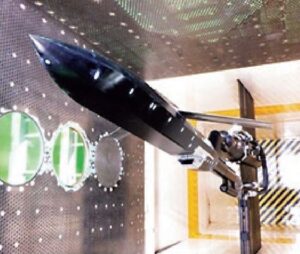
The ability to generate large amounts of electricity will allow the ASEV class to also carry directed-energy weapons from around 2033. These include high-energy lasers that are being developed to engage air targets (especially UAVs) and smaller sea targets as part of self-protection, as well as possibly microwave weapons to destroy the electronic systems on board aircraft and missiles. ASEV ships could also be equipped with a rail gun. The Japanese Navy is currently a world leader in the development and testing of this category of weapon. On 17 October, the Japanese Armed Forces Development and Procurement Agency (known internationally under the acronym ATLA - Acquisition, Technology & Logistics Agency) announced the successful sea trials of a rail gun prototype. The 5 megajoule class test weapon fires 320 gram 40mm steel projectiles with a muzzle velocity of 6.5 Mach. ATLA intends to increase the energy output to 20 MJ with a corresponding increase in projectile velocity and range. The weapon is intended for defence against sea and air targets and is also capable of intercepting hypersonic missiles.
Deployment concept
The main mission of the new ship type is to protect the Japanese islands from medium-range ballistic missiles, hypersonic glide missiles and cruise missiles. Consequently, the ships will primarily be deployed in the Sea of Japan between the main Japanese islands and Korea. According to retired Vice Admiral Tokuhiro Ikeda, the ASEV units will not remain permanently deployed, but will move into position according to the respective threat situation. Thanks to the increased manoeuvrability of the new ASEV design, the ships will have the same mobility as destroyers and will be able to constantly change their position to make it more difficult for the enemy to target them. In addition to the ABM and hypersonic defence mission, the ASEV units will also be able to perform other naval warfare tasks, at least in the context of self-protection.
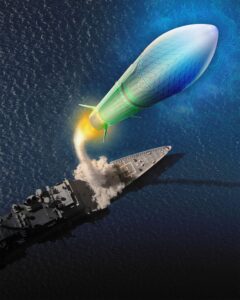
will be introduced on Asev ships after 2032, graphic: Raytheon
The planned armament with Tomahawk cruise missiles with a range of around 1,000 SM will also enable the ships to attack land targets throughout North Korea. Like the guided missile destroyers, the ASEV units will thus have a "counter-strike capability". However, attacks on enemy land targets will only take place after a missile attack against Japanese territory has been carried out, with the retaliatory strikes being directed exclusively against enemy missile positions in order to prevent the enemy's ability to carry out further attacks. According to the Japanese government, this new concept for the JMSDF should ideally have a deterrent effect.
Development and procurement programme
Ultimately, the introduction of the dedicated ABM ships will allow the Japanese Navy to focus its combat-power-enhanced destroyers primarily on operations against enemy naval forces or to provide force protection for Japanese and US aircraft carriers and amphibious ships.
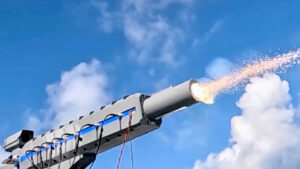
The Japanese Ministry of Defence commissioned Mitsubishi Heavy Industries to build the first ASEV unit and Japan Marine United to build the second ship. Procurement costs of 2.6 billion US dollars are estimated for each unit. Construction of the type ship is scheduled to begin in 2024. According to the Ministry of Defence, the two ships are to be formally commissioned in 2027 and 2028 respectively. In view of the extended range of capabilities of the design presented this year, there is even speculation that ASEV - as a de facto guided missile cruiser - could form the basis of the successor to the Maya class in future.
Sidney E. Dean
